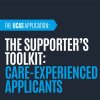
With the revised 2025 statutory careers guidance now live, we’re using the next eight newsletters to break it down, one Gatsby Benchmark at a time, focusing on what it actually means in practice.
We won’t be quoting it line by line, so we strongly recommend you read the full guidance. But we will be helping you make sense of it, prioritise what matters, and put it into action.
We’ll also show you how UCAS can support, with free, practical resources to help you meet the requirements, support your students, and do it all without needing a big budget – because we know you don’t have one. We’re here to make this easier and more effective.
Start with a careers audit
The guidance has changed, so now’s the time to pause and reassess your stable programme including:
- Where are you strong?
- Where do you need to develop?
- What’s already started and what needs refining?
Even if your planning for next year is underway, a pause to review will help you embed, engage, and inspire more effectively. Central to your plans could be the UCAS Hub, as it can serve as a a central platform to hang your programme around, where students can explore careers, courses, and apprenticeships while developing personalised plans for their future.
Get senior leadership on side
If this is going to work, leadership has to back it (and the duty says so!). Your plan isn’t just about showing off the great things, it should also show where it’ll fall short without support.
That means:
- securing buy-in for budgets and resources
- discussing creative ways to deliver personal guidance and work experience, two of the toughest areas under the new duty. Make use of the UCAS virtual work experience portal to help
- ensuring the careers lead is appropriately trained (a key requirement in the guidance). And be clear on what ‘appropriately trained’ for the different roles are – many can access training via the CEC for a Careers Leader qualification but note this does not train you to deliver careers guidance.
When SLT and governors are invested, the rest of the school follows. Also think about influencers – people other staff listen to. Get them on board and use them to build momentum.
UCAS also supports this connected approach, with readymade structured careers resources that teachers can easily embed into your programme, without creating a whole load of work for them.
Parents: Make them part of the team
Parents can be powerful allies and the new guidance wants them included.
- Show them what you’re doing and where their input is needed.
- Let them be champions of the programme, both to staff and their own children, by keeping them updated on what you’re doing and why (sell them the benefits to their children rather than talking about benchmarks you’ll meet).
- Keep them informed, not just the wins but share when you need help – like offering work experience opportunities or fundraising.
Evaluation: Listen and adapt
Evaluation isn’t about ticking boxes. It’s about:
- listening properly to feedback
- adjusting your programme, where needed
- showing that you’re responding to student needs, particularly for those with SEND, and sharing how you’re adapting
There’s flexibility in the guidance to meet the needs of your individual centre, but you’ll need to evidence it. That matters, especially when Ofsted come calling.
The UCAS Career Quiz is a great place to start as it helps students explore options aligned to their interests – an easy way to personalise support and show progress.
Keep communicating
The duty says to put your careers programmes on your website, but don’t just leave it there. Real engagement comes from consistent, clear updates and not just a one-off. Keep everyone in the loop: SLT, staff, students, and parents – not just on what you’re doing, but why it matters, and the impact it’s having.
Next month...
We’ll be focusing on Gatsby Benchmark 2: Learning from career and labour market information.
We’ll examine the implications of the new statutory duty for your careers programme and share key strategies to support successful implementation.




